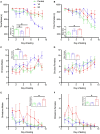Long-term effects of neonatal single or multiple isoflurane exposures on spatial memory in rats
- PMID: 23847588
- PMCID: PMC3703565
- DOI: 10.3389/fneur.2013.00087
Long-term effects of neonatal single or multiple isoflurane exposures on spatial memory in rats
Abstract
General anesthetics are neurotoxic to neonatal rodents and non-human primates. Neonatal exposure to general anesthetics has been associated with long-term cognitive deficits in animal models. Some data from humans are consistent with long-term deleterious effects of anesthetic exposure early in life on cognitive development, with multiple exposures to general anesthetics being particularly damaging. We sought to determine whether repeated exposure of neonatal rats to anesthesia was associated with long-term cognitive impairments and whether the magnitude of impairments was greater than that resulting from a single exposure. Male or female Long-Evans rat pups were exposed to 1.8% isoflurane for 2 h on postnatal day (P) 7, or for 2 h each on P7, P10, and P13. Testing in a spatial working memory task began on P91. Rats that were repeatedly exposed to isoflurane were impaired relative to controls in the spatial working memory task. Male rats that received a single exposure to isoflurane showed an unexpected facilitation in spatial memory performance. These results support the hypothesis that multiple neonatal exposures to general anesthesia are associated with greater long-term cognitive impairment than a single exposure. The findings are congruent with human epidemiological studies reporting long-term cognitive impairments following multiple but not single general anesthetics early in life.
Keywords: Hippocampus; anesthetic neurotoxicity; cognitive impairment; neurodevelopment; pediatric anesthesia.
Figures

Similar articles
-
Long-term effects of single or multiple neonatal sevoflurane exposures on rat hippocampal ultrastructure.Anesthesiology. 2015 Jan;122(1):87-95. doi: 10.1097/ALN.0000000000000477. Anesthesiology. 2015. PMID: 25289484
-
Neonatal Isoflurane Exposure in Rats Impairs Short-Term Memory, Cell Viability, and Glutamate Uptake in Slices of the Frontal Cerebral Cortex, But Not the Hippocampus, in Adulthood.Neurotox Res. 2022 Dec;40(6):1924-1936. doi: 10.1007/s12640-022-00607-2. Epub 2022 Nov 28. Neurotox Res. 2022. PMID: 36441450
-
Exposure to sevoflurane anesthesia during development does not impair aspects of attention during adulthood in rats.Neurotoxicol Teratol. 2017 Mar-Apr;60:87-94. doi: 10.1016/j.ntt.2016.11.010. Epub 2016 Dec 2. Neurotoxicol Teratol. 2017. PMID: 27919700
-
Use of anesthetic agents in neonates and young children.Anesth Analg. 2007 Mar;104(3):509-20. doi: 10.1213/01.ane.0000255729.96438.b0. Anesth Analg. 2007. PMID: 17312200 Review.
-
Beyond anesthetic properties: the effects of isoflurane on brain cell death, neurogenesis, and long-term neurocognitive function.Anesth Analg. 2010 Feb;110(2):431-7. Anesth Analg. 2010. PMID: 25508825 Review.
Cited by
-
Construction and Characterization of a Population-Based Cohort to Study the Association of Anesthesia Exposure with Neurodevelopmental Outcomes.PLoS One. 2016 May 11;11(5):e0155288. doi: 10.1371/journal.pone.0155288. eCollection 2016. PLoS One. 2016. PMID: 27167371 Free PMC article.
-
Neonatal ketamine exposure causes impairment of long-term synaptic plasticity in the anterior cingulate cortex of rats.Neuroscience. 2014 May 30;268:309-17. doi: 10.1016/j.neuroscience.2014.03.029. Epub 2014 Mar 24. Neuroscience. 2014. PMID: 24674848 Free PMC article.
-
Effect of Isoflurane Exposure with Administration of Polyunsaturated Fatty Acids on Cognition in Developing Rats.Turk J Anaesthesiol Reanim. 2020 Dec;48(6):477-483. doi: 10.5152/TJAR.2020.128. Epub 2020 Dec 1. Turk J Anaesthesiol Reanim. 2020. PMID: 33313587 Free PMC article.
-
Isoflurane Anesthesia Has Long-term Consequences on Motor and Behavioral Development in Infant Rhesus Macaques.Anesthesiology. 2017 Jan;126(1):74-84. doi: 10.1097/ALN.0000000000001383. Anesthesiology. 2017. PMID: 27749311 Free PMC article.
-
Juvenile Rats Show Altered Gut Microbiota After Exposure to Isoflurane as Neonates.Neurochem Res. 2019 Apr;44(4):776-786. doi: 10.1007/s11064-018-02707-y. Epub 2019 Jan 2. Neurochem Res. 2019. PMID: 30603984
References
-
- Fredriksson A, Ponten E, Gordh T, Eriksson P. Neonatal exposure to a combination of n-methyl-d-aspartate and γ-aminobutyric acid type A receptor anesthetic agents potentiates apoptotic neurodegeneration and persistent behavioral deficits. Anesthesiology (2007) 107(3):427–3610.1097/01.anes.0000278892.62305.9c - DOI - PubMed
LinkOut - more resources
Full Text Sources
Other Literature Sources

